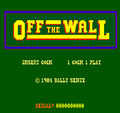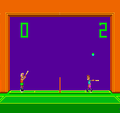Namcorules (talk | contribs) (Bally Sente) |
m (Update infobox) |
||
| Line 1: | Line 1: | ||
{{Header Nav|game=Off the Wall | {{Header Nav|game=Off the Wall}} | ||
{{ | {{Game | ||
|completion=2 | |||
|image=Off the Wall flyer.jpg | |||
|title=Off the Wall | |title=Off the Wall | ||
| | |developer={{colist|Sente|Bally Sente}} | ||
| | |publisher={{colist|Sente|Bally Sente}} | ||
|publisher= | |year=1984 | ||
| | |systems={{syslist|cade}} | ||
| | |genre=[[Tennis]] | ||
| | |||
|players=1-2 | |players=1-2 | ||
|modes=[[Single player]], [[Multiplayer]] | |modes=[[Single player]], [[Multiplayer]] | ||
}} | }} | ||
{{game disambig|the [[1984]] [[Bally]]/[[Sente]] game|the [[1991]] [[Atari]] game|[[Off the Wall (1991)]]}} | |||
{{marquee|Off the Wall marquee.jpg}} | |||
'''Off the Wall''' is a {{c|tennis}} arcade game, that was released by [[Bally]] and [[Sente]] in [[1984]]; it is the fourth of the original batch of eight games to run on their SAC-I hardware, and the players must use two 2-way joysticks to move two tennis players left and right, on their respective sides of the net, with a trackball (which is limited to a horizontal movement) for rotating their right (racket-holding) arms and hitting the ball. The amount of points both players have scored will be displayed above them, on their respective sides of the net - and, unlike in real tennis, the game will only award a single point for every time your opponent fails to return the ball. The game is over when one player has scored eleven points; if there is only one player present, it is also worth noting that the second player will be controlled by the CPU. | '''Off the Wall''' is a {{c|tennis}} arcade game, that was released by [[Bally]] and [[Sente]] in [[1984]]; it is the fourth of the original batch of eight games to run on their SAC-I hardware, and the players must use two 2-way joysticks to move two tennis players left and right, on their respective sides of the net, with a trackball (which is limited to a horizontal movement) for rotating their right (racket-holding) arms and hitting the ball. The amount of points both players have scored will be displayed above them, on their respective sides of the net - and, unlike in real tennis, the game will only award a single point for every time your opponent fails to return the ball. The game is over when one player has scored eleven points; if there is only one player present, it is also worth noting that the second player will be controlled by the CPU. | ||
<gallery> | <gallery> | ||
| Line 25: | Line 24: | ||
{{ToC}} | {{ToC}} | ||
[[Category:Tennis]] | [[Category:Tennis]] | ||
[[Category:Single player]] | [[Category:Single player]] | ||
[[Category:Multiplayer]] | [[Category:Multiplayer]] | ||
[[Category:MAME]] | [[Category:MAME]] | ||
Latest revision as of 22:37, 5 November 2022

| Off the Wall | |
|---|---|
| Developer(s) | Sente, Bally Sente |
| Publisher(s) | Sente, Bally Sente |
| Year released | 1984 |
| System(s) | Arcade |
| Genre(s) | Tennis |
|---|---|
| Players | 1-2 |
| Modes | Single player, Multiplayer |
Off the Wall is a tennis arcade game, that was released by Bally and Sente in 1984; it is the fourth of the original batch of eight games to run on their SAC-I hardware, and the players must use two 2-way joysticks to move two tennis players left and right, on their respective sides of the net, with a trackball (which is limited to a horizontal movement) for rotating their right (racket-holding) arms and hitting the ball. The amount of points both players have scored will be displayed above them, on their respective sides of the net - and, unlike in real tennis, the game will only award a single point for every time your opponent fails to return the ball. The game is over when one player has scored eleven points; if there is only one player present, it is also worth noting that the second player will be controlled by the CPU.
-
Title screen.
-
Screenshot of the game.


